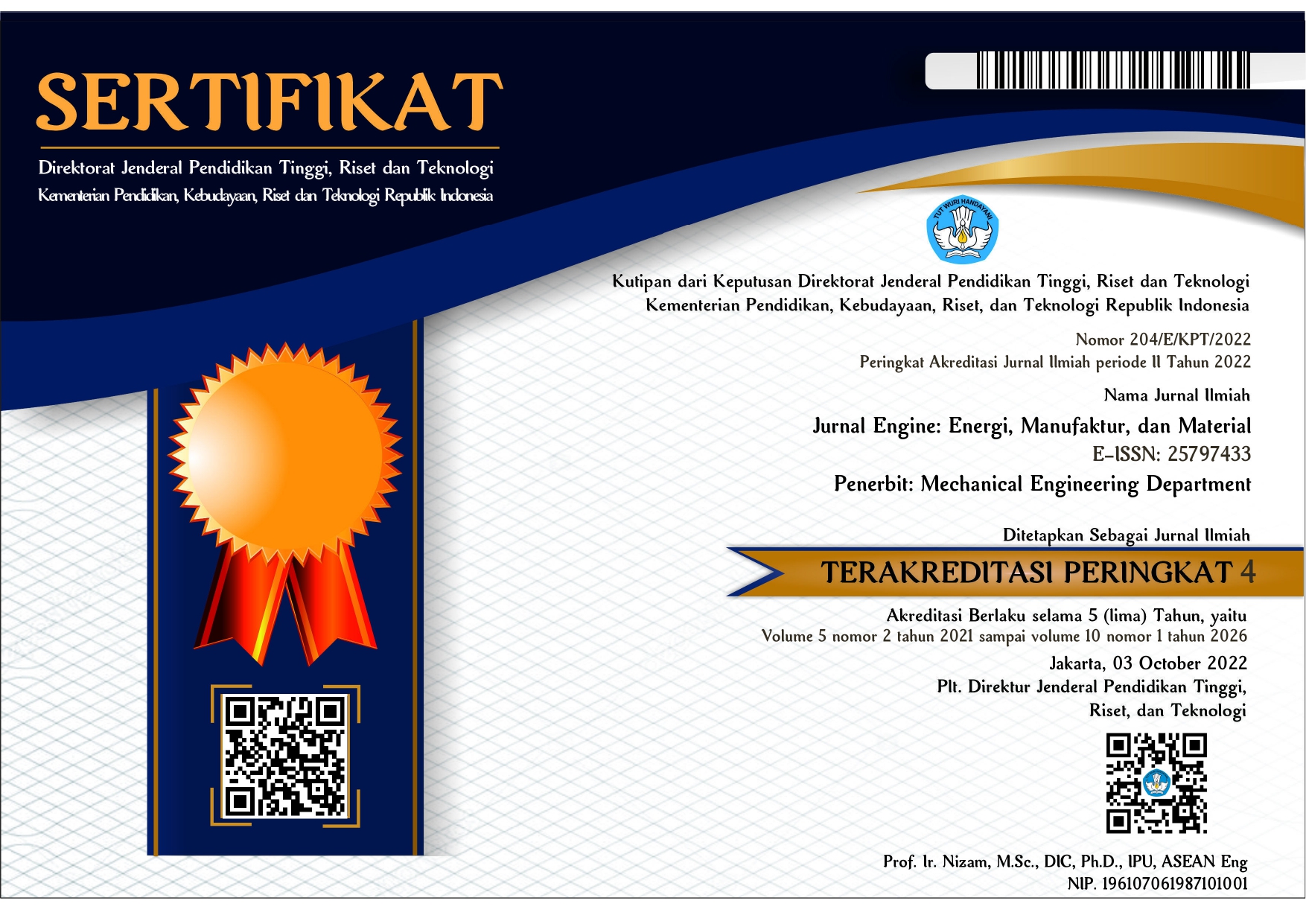Analisis Sootblower Terhadap Head Transfer Economizer Pada Boiler
DOI:
https://doi.org/10.30588/jeemm.v6i1.912Keywords:
Sootblower, Temperature, EconomizerAbstract
The Ministry of Energy and Mineral Resources (ESDM) said that the current national electricity consumption is still relatively small, namely one-quarter of the indicators of developed countries in the world. With a figure of 956 Kilowatt-hour (KWh) per capita, Indonesia's electricity consumption has only reached 23.9% of the electricity consumption of developed countries of 4000 KWh per capita. Based on field observation data, the temperature in the economizer pipe ranges from 280 0C to 330 0C even though it should be between 350 0C to 470 0C (Manual Book PT. Wijaya Triutama) is based on operational standards for a maximum load of 4 MW. A decrease in the temperature in the economizer pipe which is already below the limit will certainly cause a reduction in the electrical power generated and then fuel consumption will increase from 5 tons of wood waste per hour to 7 tons of wood waste per hour. Based on data analysis and discussion, conclusions can be drawn regarding the economizer analysis on boilers that work below the normal limit of gas temperature of 330.9 0C which should be normal temperature of 470.6 0C then water temperature of 152.3 0C which should be 234.8 0C due to several factors including is the contamination in the economizer pipe which causes the temperature to drop, then the efficiency value in the economizer before the research is 58.0% and after repairs and cleaning of the economizer pipe is 70.2% the value of the temperature increase is very influential on the boiler that produces steam pressure Very large.
References
Achirul Supomo. 2015. Analisis Kinerja Economizer Pada Boiler Di PLTU Rembang Unit 2 Jurusan Teknik Mesin Universitas Gadjah Mada Yogyakarta.
Gumelar G 2017 Konsumsi Listrik Nasional Masih Seperempat Negara Maju Retrieved From https://www.cnnindonesia.
Jhon E, Edwards. 2008. Design and Rating Shell and Tube Heat Exchanger, Teesside UK.
Markoni. 2015. Analisa Kepuasan Pelangan PT PLN (Persero) Terhadap Proses Pemasangan Listrik Prabayar, Jurnal Manajemen dan Bisnis, Vol 13. No 4
Putu Wijaya Sunu, 2008. Analisa Perbandingan Pemasangan Sirip pada Pipa Bergetar Terhadap Perpindahan Panas, Jurnal Cakram Vol. 2 No 1
Sugiyanto, 2014. Analisa Alat Penukar Kalor Tipe Shell and Tube dan Aplikasi Perhitungan Microsoft Visiual Basic 6.0 Jurnal Gunadarma Vol 3. No. 1
Yopi Handoyo dan Ahsan, 2012, Analisa Kinerja Alat Penukar Kalor Jenis Shell and Tube Pendingin Aliran Air pada PLTA Jatiluhur, Jurnal Energi dan Manufaktur Vol 5. No, 1
Laser Welded Low Carbon Steel with Stainless Steel 304 Based on Computation Simulation. Proceeding International Conference on Materials Science and Technology (pp. 72-79). Serpong: Center for Science and Technology of Advanced Materials - BATAN.
Astu Pudjanarsa & Djati Nursuhud. (2013). Mesin Konversi Energi. Yogyakarta: CV. Andi Offset.
Downloads
Published
How to Cite
Issue
Section
License
Authors who publish with Jurnal Engine: Energi, Manufaktur, dan Material agree to the following terms:
Authors retain copyright and grant the Jurnal Engine: Energi, Manufaktur, dan Material right of first publication with the work simultaneously licensed under a Creative Commons Attribution 4.0 International License that allows others to share (copy and redistribute the material in any medium or format) and adapt (remix, transform, and build upon the material) the work for any purpose, even commercially with an acknowledgment of the work's authorship and initial publication in Jurnal Engine: Energi, Manufaktur, dan Material. Authors are able to enter into separate, additional contractual arrangements for the non-exclusive distribution of the journal's published version of the work (e.g., post it to an institutional repository or publish it in a book), with an acknowledgment of its initial publication in Jurnal Engine: Energi, Manufaktur, dan Material. Authors are permitted and encouraged to post their work online (e.g., in institutional repositories or on their website) prior to and during the submission process, as it can lead to productive exchanges, as well as earlier and greater citation of published work (See The Effect of Open Access).


















